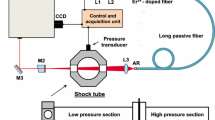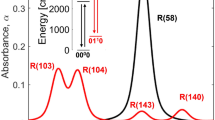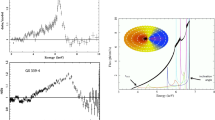Abstract
Explosive breakout of PBX-9407 into air is examined using time-resolved optical spectroscopy over a period of several microseconds. Emission is monitored over the 250–700 nm range, and several atomic and molecular species are observed including atomic calcium, and copper, as well as OH and CN. Several lines and bands remain unidentified. Fits to Ca and OH spectra suggest that early time temperatures exceed 13,000 K behind the air shock and that temperature decay is fairly rapid over the first \(10\,\upmu \mathrm{s}\). Considering the proposed shock structure of the blast wave, it is likely that these temperatures are confined to a narrow region behind the blast wave, but nevertheless generate emission signatures that dominate the spectra at early times.







Similar content being viewed by others
References
Kiselev, Y.N., Khristoforov, B.D.: Explosive high-power continuous spectrum light source. Fizika Goreniya i Vzryva 10, 116–119 (1974)
Taylor, W.H., Kane, J.W.: Radiant properties of strong shock waves in argon. Appl. Opt. 6, 1493–1496 (1967)
Koch, J.D., Piecuch, S., Lightstoner, J.M., Carney, J.R., Hooper, J.: Time-resolved measurements of near infrared emission spectra from explosions: pure pentaerythritol tetranitrate and its mixtures containing silver and aluminum particles. J. Appl. Phys. 108, 036101 (2010)
Glumac, N., Krier, H., Bazyn, T., Eyer, R.: Temperature measurements of aluminum particles burning in carbon dioxide. Combust. Sci. Technol. 177, 485–501 (2005)
Schlöffel, G., Eichhorn, A., Albers, H., Mundt, C., Seiler, F., Zhang, F.: The effect of a shock wave on the ignition behavior of aluminum particles in a shock tube. Combust. Flame 157, 446–454 (2010)
Keck, J.C., Camm, J.C., Kivel, B.: Radiation from hot air part II. Shock tube study of absolute intensities. Ann. Phys. 7, 1–38 (1959)
Carroll, P.K., Collins, C.C., Murnaghan, J.T.: Rotational studies of the Gaydon-Herman (green) bands of N\(_2\). J. Phys. B Atomic Mol. Opt. Phys. 5, 1634–1654 (1972)
Davidson, G., O’Neil, R.: Optical radiation from nitrogen and air at high pressure excited by energetic electrons. J. Chem. Phys. 41, 3946–3955 (1964)
Aho, K., Berg, L.E., Hallsten, U., Lindblom, P., Solin, O.: Observation of dominant emission of the Gaydon-Herman green system in dense nitrogen excited by energetic ions. J. Phys. B Atomic Mol. Opt. Phys. 27, L525 doi:10.1088/0953-4075/27/16/004
James, C.G., Sugden, T.M.: A new identification of the flame spectra of the alkaline-earth metals. Nature 175, 333–334 (1955)
Weeks, S.J., Haraguchi, H., Winefordner, J.D.: Laser-excited molecular fluorescence of CaOH in an air-acetylene flame. J. Quant. Spectro. Radiat. Transf. 19, 633–640 (1978)
Bernath, P.F., Brazier, C.R.: Spectroscopy of CaOH. Ap. J. 288, 373–376 (1985)
Xu, H., Glumac, N.G., Suslick, K.S.: Temperature inhomogeneity during multibubble sonoluminescence. Angewandte Chemie 48, 1–5 (2009)
Luque, J., Crosley, D.R.: LIFBASE: database and spectral program (version 1.5). SRI International Report MP 99–009 (1999)
Brode, H.L.: Blast wave from a spherical charge. Phys. Fluids 2, 217 (1959)
Rozhdestvenskii, V.B., Khristoforov, B.D., Yur’ev, V.L.: Effect of product composition on the radiation characteristics of explosion of an explosive in air. Fizika Goreniya i Vzryva 25(5), 145–148 (1989)
Reif, I., Fassel, V.A., Kniseley, R.N.: Spectroscopic flame temperature measurements and their physical significance—I. Theoretical concepts—a critical review. Spectrochimica Acta Part B Atomic Spectrosc. 28, 105–115 (1973)
Reif, I., Fassel, V.A., Kniseley, R.N.: Spectroscopic flame temperature measurements and their physical significance—II. Spectrochimica Acta Part B Atomic Spectrosc. 29, 79–84 (1974)
Grabner, L., Hastie, J.W.: Flame boundary layer effects in line-of-sight optical measurements. Combust. Flame 44, 15–22 (1982)
McNesby, K.L., Homan, B.E., Ritter, J.J., Quine, Z., Ehlers, R.Z., McAndrew, B.A.: Afterburn ignition delay and shock augmentation in fuel rich solid explosives. Propellants Pyrotech. Explos. 35, 57–65 (2010)
Coverdill, D.: Explosive Initiation of Tungsten Based Reactive Materials in Air, M.S. Thesis. University of Illinois, Urbana–Champaign (2010)
Carney, J.R., Firestone, J.M., Lee, R.J.: Fuel-rich explosive energy release: oxidizer concentration dependence. Propellants Explos. Pyrotech. 34, 331–339 (2009)
Glumac, N., Mott Puker, J., Krier, H., Lynch, P.T.: Optical Spectroscopy of Fireballs from Metallized Reactive Materials. In: 48th AIAA Aerospace Sciences Meeting. Orlando, Florida, AIAA-2010-0695 (January 2010)
Lewis, W.K., Rumchik, C.G.: Measurement of apparent temperature in post-detonation fireballs using atomic emission spectroscopy. J. Appl. Phys. 105, 056104 (2009)
Johnson, S.: AFRL Eglin. Private communication
Carney, J. R.: NSWC Indian Head. Private communication
Acknowledgments
This work was supported by the Defense Threat Reduction Agency under contract HDTRA1-10-1-0003. The program manager is Dr. Suhithi Peiris. Thanks to Dr. Stephanie Johnson at AFRL Eglin for assistance in identification of the green and red emission bands, to Drs. William Lewis and Joel Carney for helpful discussions on emission spectra, and to Drs. Scott Stewart, Blaine Asay, Doug Tasker, and Joe Foster for insightful information on detonation breakout.
Author information
Authors and Affiliations
Corresponding author
Additional information
Communicated by F. Zhang.
Rights and permissions
About this article
Cite this article
Glumac, N. Early time spectroscopic measurements during high-explosive detonation breakout into air. Shock Waves 23, 131–138 (2013). https://doi.org/10.1007/s00193-012-0421-8
Received:
Revised:
Accepted:
Published:
Issue Date:
DOI: https://doi.org/10.1007/s00193-012-0421-8




